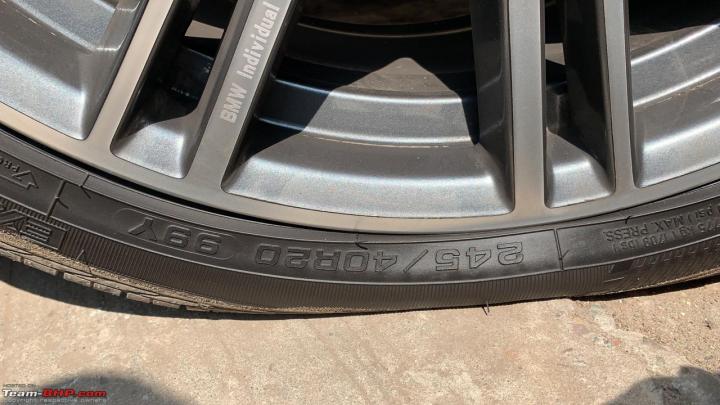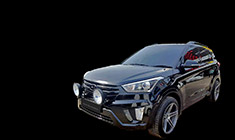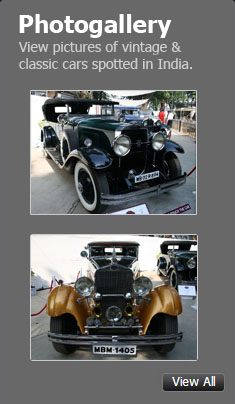News
Advice needed: Overcoming anxiety associated with tyre punctures
When I drove a Honda city for close to 10 years, never had this anxiety coz I mostly did city driving and had a full size spare tyre.
BHPian Dracoon recently shared this with other enthusiasts.
I bought Audi Approved A3 about 3 months back and have had 2 incidence of tyre puncture. The first one was a side wall rupture, I do not know how it happened, as I was driving and suddenly TPMS warning came. Since I wanted to claim warranty for tyre, I could not even get it repaired and had no other option but to use the space saver tyre.
What I realized from that experience is space saver tyre sucks. So essentially, I kept getting TPMS warning, I could not use cruise control, had to drive below 80 km. on empty highway, central locking did not work. In summary the driving experience was very poor and unsafe. To add it, the car looked ridiculous.
Recently I noticed that I am loosing pressure at a very slow rate (drop from 36 psi to 25 in 2 weeks) and got it checked, it was a puncture. There was a board pin (like we used in our classrooms), have no idea how that thing ended up on road and in my tyre.
Now with 2 instances in 3 months, I have developed an anxiety specially because of the poor experience of drive with space saver tyre . When I drove Honda city for close to 10 years, never had this anxiety coz I mostly did city driving and had a full size spare tyre. The condition of Indian roads are not confidence inspiring. So I need to have a solution, as of now I have considered the following solutions:
- Portable tyre inflator - I have already bought it works like a charm. For small punctures I can keep filling the tyre and not worry too much till I get a puncture repair shop. However the first instance when I had a side wall tear, I did not work because the rate of loss of pressure was very high.
- Puncture repair kit - Flipkart has some really cheap ones, not sure if they are any good. But thinking of keeping them just in case as back-up
- Changing space saver tyre to a regular size tyres - Audi gave me a estimate of ~70k for change of alloy wheel and tyre. Checked with FNG, he was offering allow wheel of a different car (Nexon i think) for 4.5k and with tyre it would have costed like 12-13k. The allow wheel looked different but I would have taken it. However, when I put the full size wheel in the wheel well, the boot floor raised quite a bit (more than expected). No way I'll keep the boot like that forever. Could be an option for only long trips. But i don't have a place to store spare tyre (Living in rented accommodation)
- Puncture Sealant: When I went to get the 2nd puncture repaired, the FNG suggested I get the puncture sealant added to the tyre. It would cost me 600 bucks (including labour) for each tyre and then the sealant would seal any punctures going forward. The mechanic even claimed it would work on side wall punctures. Now if it does work like he says, it is indeed very enticing but I did not want to get if filled in only 1 tyre as I felt it would affect the wheel balancing. And if I do it, will get it filled in all tyres. I wanted to check with this group if this is indeed a good idea. What are the pros and cons of adding puncture sealant in the tyres? Attaching the pics of the ones FNG was showing. Do let me know if anyone has had an experience with these things
Also to mention, I am using Pirelli Cinturato P7 tyres and I was not happy when they flatly refused to replace the tyres which I drove for less than 300km and it got side wall puncture (not repairable as per dealer). After some angry mails, as a good will gesture I got 70% discount on the replacement. Next time I am thinking of going with a Indian manufacturer who has a unconditional warranty like CEAT or JK (though not sure if they make good enough tyres). Anyways will come back for guidance when my tyres are worn out.
So folks, do let me know what else can I do to reduce my anxiety about tyre punctures. I do want to take my car on long trips but not get stuck/ drive with space saver tyres because of punctures. Should I go for puncture sealants? If yes any good brand or place you would recommend in Pune?



Here's what BHPian RubberGuru1113 had to say on the matter:
Okay first and foremost - I'm a tyre industry professional - aftermarket tyre sealants do more harm than good when used as a preventive measure. And no, they are absolutely useless when it comes to sidewall injuries. Let me explain why.
The idea of using these sealants is that they would form a thick, viscous film on the tyre's inner liner, and would seep into any gaps created by an external injury - if you notice, the can itself mentions a maximum injury size of 6mm - we will get back to this point later, remember this.
This is a great solution in theory, in fact, it is a slightly watered down version of something many tyre manufacturers offer abroad (JK recently launched it in India) which is a similar sealant which is applied right after the tyre is manufactured. Sealants applied at the point of manufacturing are of much better adhesive strength and quality compared to what we can buy in the aftermarket like the product you mentioned - they are imported as blocks, liquefied in the factory with heat, and then sprayed on to the tyre in an automated process which ensures that the coating is even throughout the inner circumference of the tyre. Most importantly, the coating is applied only on the tread part. In most cases, manufacturer-applied sealants last as long as the life of the tyre due to the material quality and automation involved. Plus, when applied on brand new tyres, there is no dirt or contamination on the inner surface which can reduce the adhesive strength, whereas no amount of cleaning even on lightly used tyres will remove all the dust and dirt that has accumulated. Hence, aftermarket sealants such as this would eventually solidify into balls on losing their adhesive strength, eventually fall off the inner surface, and would rattle around inside your tyre. Any sealant applied on the sidewall will be the first to fall off due to the combination of the effect of gravity and the constant flexing it goes through compared to the tread portion which is relatively rigid. Even without this issue, like I mentioned before, these work on an injury size of max 6 mm, and sidewall injuries are typically much larger, which makes it a moot point. On top of all this, most tyre manufacturers have it in their T&C that usage of aftermarket sealants would void warranty. This clause would be usually mentioned as "chemical application/contamination".
Now, coming to offering you a solution to mitigate anxiety, you have already thought of 2 solutions - DIY repair kit and a portable inflator. The only caveat is that a DIY puncture fix is not easy/intuitive and would recommend that you practice a few times on an old tyre carcass that you can get from a puncture shop. There's also a step-by-step guide on this forum.
Keep in mind that the "outside-in" plug puncture repair is a temporary solution and it is always better to take it to a tyre shop (I recommend any MRF T&S, most of their shops offer this) later for a permanent fix, also called a "mushroom repair" which is repaired from the inside of the tyre. Keep in mind that the sidewall is never to be repaired, and whatever I said is applicable only for the tread portion. Sidewall injuries warrant only tyre replacement.
Regarding tyre replacement - for one, I'd like to go back to the question of the tyre size. If you're using 225/45R17, I'd exhort you to swap to 225/50R17, which has a 10 mm taller sidewall and would exponentially reduce the likelihood of damage. Pre-2012 C Class used to come with 225/45 as well and persistent tyre issues forced Merc to change to 225/50, a size which continues even today. The change in diameter (3.5%) is slightly more than the recommended 3% but I have personally done this upgrade on one of my friends' C Class and there is no fouling even on full load at speed breakers. In any case, I think your A3 would come with wheel stoppers which would prevent this.
Finally, coming to your spare tyre, one of our BHPians, Chethan Sir, has taken the plunge and modified his BMW X1's boot with wooden blocks to fit the full size spare, linking the post
If the official Audi wheels are too expensive for you, there are a few solutions:-
1. Like you mentioned, going for an alloy of a different vehicle. Just take care that the PCD is the same, and that there is no fouling with brake calipers. Do a fitment trial (on both front and rear) before making the purchase.
2. Go for a slightly smaller alloy from Audi - 16 inchers. And do not buy the tyres from them. Go for a tyre size from a cheaper brand like JK or Ceat like 205/55R16 or (which keeps the outer diameter equivalent to the stock tyres) and still wide enough for you to use the vehicle at higher speeds. This would be my recommended solution because cross-manufacturer rim compatibility is a huge grey area and many things can go wrong. Meanwhile you can dispose the space saver on OLX.
Hope I have answered all your queries, do reply here or PM if there's anything else I can help with.
Cheers.
BHPian Dracoon replied:
Thanks for taking time and clarifying on all points. You are totally justifying your username.
To answer your question on the wheel size, it is 205/55 R16 Pirelli Cinturato P7. I think this is a pretty standard size tyre. I know lot of people want to upgrade to bigger or wider tyre, but frankly the current size works for me, looks proportionate.
Now this is the first time I have used Pirelli tyres and when I got the sidewall tear in the 1st month, my confidence in the brand kind of shook. Attaching the pictures of the side wall failure. The company denied warranty saying it is accidental damage, but there was no accident. The shape of the tear is also not a regular cut. Till date no one has told me the reason why it happened. Maybe you can shed some light on the mystery.
On the puncture sealant, I thought it is too good to be true. The FNG was insisting that I get it filled in the 1 tyre he repaired as he had already demounted it. I did not go for it because I did not want to add weight only to 1 tyre and really want to check with someone more knowledgeable. Thank you for detailing the cons of aftermarket product.
I do like it as a concept, and I will seriously consider JK or any another tyre manufacturer which offers this + unconditional warranty.
Thanks for sharing the post by Chethan sir, that is definitely an option I want to consider.
Here's what BHPian el lobo 6061 had to say on the matter:
Pirelli Cinturato P7 are soft tyres and prone to damage. Using them on BMW X1 and face issue of cuts by stones during touring.
I would suggest you to go for Yokohama Earth1 which is available in 205 55 R16 size. Best touring tyres suited for Indian road conditions. Comes with 18 months unconditional warranty.
Intend to use the same on X1.
Here's what BHPian rpunwani had to say on the matter:
I have had experience of sidewall damage on my VW Passat with Pirelli Cinturato P7 tyres (very soft sidewalls). In due course I replaced them with Yokohama Blue Earth, which were very good. I sold the car in 2021, the current owner is still using the Yokohama tyres.
Would highly recommend the Yokohama's.
Read BHPian comments for more insights and information.




















